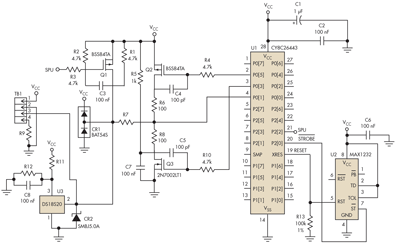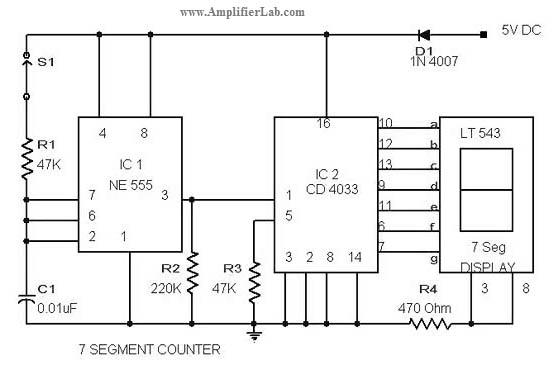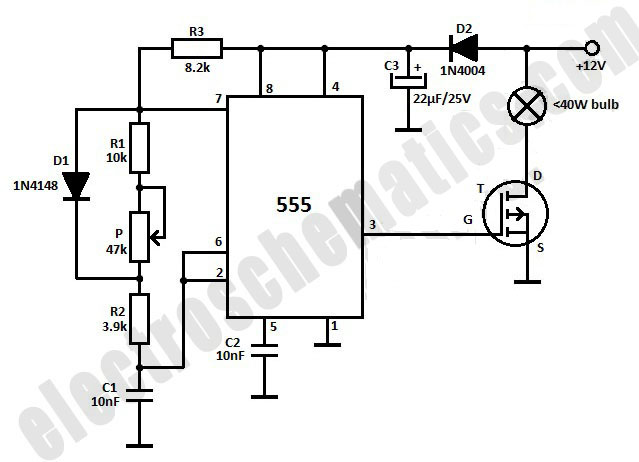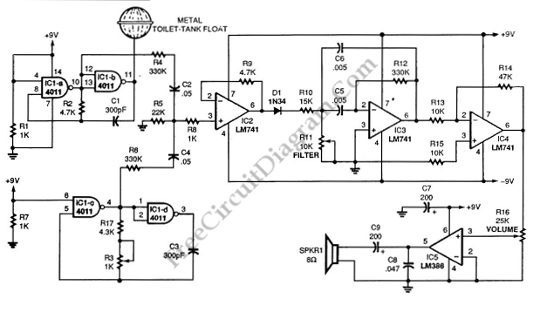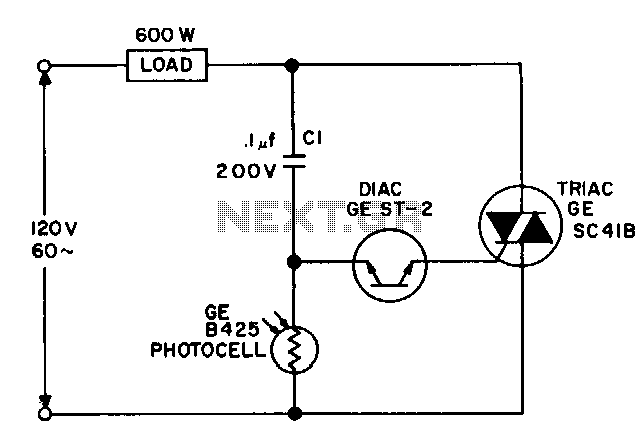
Dual-phase power switchover circuit schematic
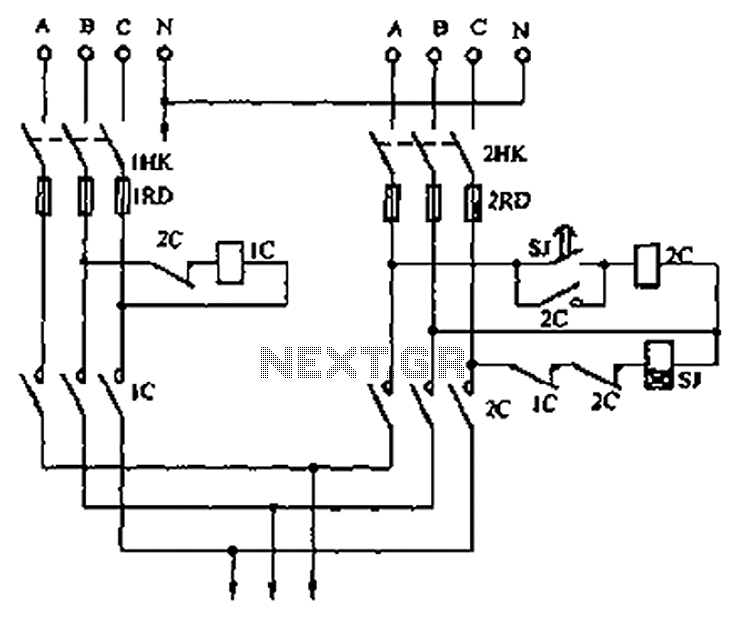
A dual three-phase power line circuit is illustrated in the figure. When the knife switches 1HK and 2HK are closed simultaneously, the normally closed contact 1C disconnects the power supply to the time relay SJ, allowing power to reach the load. In the event of a power outage, contactor 1C releases, causing the normally closed contact to open. This action triggers the time relay SJ, which after a predetermined delay of several seconds, causes the normally open contact to close, energizing contactor 2C and enabling self-locking. As contactor 2C engages, it disconnects the power supply from the time delay relay on one side while simultaneously interrupting the power to the coil of contactor 1C, thereby halting power supply A and ensuring that power supply B remains operational. If power supply B experiences an outage after some time, the normally closed contact of 2C automatically switches, restoring power to the load from power supply A through contactor 1C. The choice of contactor should be based on the load size, and the time relay can be set for a delay of 0 to 60 seconds for AC operation.
The dual three-phase power line circuit operates as a failover mechanism to ensure continuous power supply to a load in the event of outages in either of the two power sources (A or B). The circuit utilizes two knife switches (1HK and 2HK) to control the flow of electricity. When both switches are closed, the circuit allows current to flow to the load through the normally closed contact 1C. This configuration is designed to provide redundancy; if one power source fails, the system can automatically switch to the other source without manual intervention.
The time relay SJ plays a critical role in this circuit, providing a delay that prevents rapid cycling between power sources during transient outages. The adjustable time delay (0 to 60 seconds) allows for flexibility based on the specific application and load requirements. Once the time relay is activated after a power failure, it transitions from its normally open state to closed, energizing contactor 2C. This contactor is responsible for maintaining power to the load while disconnecting the failed power source.
The self-locking feature of contactor 2C ensures that once it is energized, it remains engaged even if the triggering signal from the time relay is removed. This is crucial for maintaining stability in the power supply to the load. The circuit is designed with safety in mind; the interruption of the power supply to contactor 1C ensures that it does not inadvertently attempt to reconnect to a failed source, thereby protecting the system from potential damage.
In summary, this dual three-phase power line circuit effectively manages power supply redundancy through the use of strategic contacts and a time relay, ensuring reliable and continuous operation of the load under varying conditions. Proper selection of contactors based on load size is essential for optimal performance and reliability of the system. As shown in Figure is a dual three-phase power line circuit from the vote. When electricity at the same time closing the knife switch 1HK and 2HK, 1C normally closed contacts d isconnect the power supply SJ time relay. Power to the load. When A power outage for any reason, 1C contactor release, then IC normally closed, power relay SJ time line on the graph, time delay relay after a few seconds, so SJ delay normally open closes, 2C was electrically energized and self-locking. Since the 2C pull its normally closed one hand off-delay line drawing power, on the other hand double break 1C coil power supply circuit, so that the power to stop power supply A, B power supply to ensure normal power supply.
After working for some time if the B power outage, 2C normally closed automatically switched line circle 1C A power supply replaced. Contactor shall choose according to load size; time relay available 0 ~ 60S AC relay.
The dual three-phase power line circuit operates as a failover mechanism to ensure continuous power supply to a load in the event of outages in either of the two power sources (A or B). The circuit utilizes two knife switches (1HK and 2HK) to control the flow of electricity. When both switches are closed, the circuit allows current to flow to the load through the normally closed contact 1C. This configuration is designed to provide redundancy; if one power source fails, the system can automatically switch to the other source without manual intervention.
The time relay SJ plays a critical role in this circuit, providing a delay that prevents rapid cycling between power sources during transient outages. The adjustable time delay (0 to 60 seconds) allows for flexibility based on the specific application and load requirements. Once the time relay is activated after a power failure, it transitions from its normally open state to closed, energizing contactor 2C. This contactor is responsible for maintaining power to the load while disconnecting the failed power source.
The self-locking feature of contactor 2C ensures that once it is energized, it remains engaged even if the triggering signal from the time relay is removed. This is crucial for maintaining stability in the power supply to the load. The circuit is designed with safety in mind; the interruption of the power supply to contactor 1C ensures that it does not inadvertently attempt to reconnect to a failed source, thereby protecting the system from potential damage.
In summary, this dual three-phase power line circuit effectively manages power supply redundancy through the use of strategic contacts and a time relay, ensuring reliable and continuous operation of the load under varying conditions. Proper selection of contactors based on load size is essential for optimal performance and reliability of the system. As shown in Figure is a dual three-phase power line circuit from the vote. When electricity at the same time closing the knife switch 1HK and 2HK, 1C normally closed contacts d isconnect the power supply SJ time relay. Power to the load. When A power outage for any reason, 1C contactor release, then IC normally closed, power relay SJ time line on the graph, time delay relay after a few seconds, so SJ delay normally open closes, 2C was electrically energized and self-locking. Since the 2C pull its normally closed one hand off-delay line drawing power, on the other hand double break 1C coil power supply circuit, so that the power to stop power supply A, B power supply to ensure normal power supply.
After working for some time if the B power outage, 2C normally closed automatically switched line circle 1C A power supply replaced. Contactor shall choose according to load size; time relay available 0 ~ 60S AC relay.
